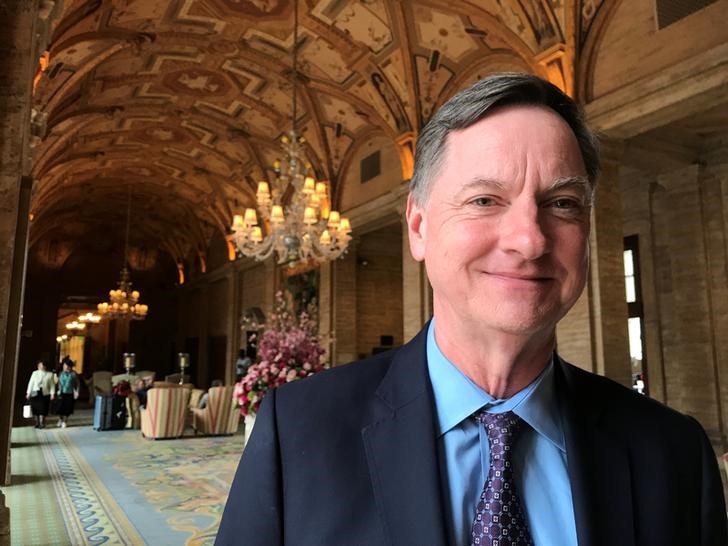 © Reuters. Charles Evans, president of the Federal Reserve Bank of Chicago, poses for a photo in Palm Beach
© Reuters. Charles Evans, president of the Federal Reserve Bank of Chicago, poses for a photo in Palm BeachBy Ann Saphir
FORT WAYNE, Ind. (Reuters) – The Federal Reserve’s interest-rate hikes will begin to drag on U.S. economic growth and employment by next year, a U.S. central banker said Friday, as the level of borrowing costs appropriately turns “mildly restrictive” after more than a decade of acting as a stimulant.
The remarks, from Chicago Federal Reserve Bank President Charles Evans, mark a turning point in the thinking of a policymaker who as recently as this past spring was trying to convince his colleagues to stop raising rates to give the economy and inflation a bit more room to run.
But on Friday, Evans said he believes that rates should continue to rise and that by next year monetary policy will begin to “hold back the economy just a little bit.”
That view contrasts with fellow Fed policymaker Lael Brainard, who argued earlier this week that even with further rate hikes it will probably be a couple years before borrowing costs start impeding growth. [L2N1VY28W]
“The U.S. economy is firing on all cylinders, with strong growth, low unemployment, and inflation approaching our 2 percent symmetric target on a sustained basis,” Evans told the Northeast Indiana Regional Economic Forum.
The economy will likely grow at 3 percent this year before slowing next year, he said, pushing unemployment down from 3.9 percent now to 3.5 percent by 2020, well below the 4.5 percent that Evans believes is sustainable over the long run. Meanwhile inflation, he said, will likely rise a bit above 2 percent, though not far enough to cause concern.
The Fed has been raising rates gradually as the economy has strengthened, and its most recent projections suggest it will continue to do so into next year before slowing in 2020.
The projections show most policymakers expect interest rates to rise to 3.1 percent by the end of next year and 3.4 percent by the end of 2020, above the Fed estimate for a neutral rate setting of 2.9 percent, Evans noted. Neutral is the estimated level of borrowing costs that in a healthy economy neither boosts nor brakes growth.
“This means that the 3 to 3.5 percent level of the funds rate projected for 2019 and 2020 is mildly restrictive,” Evans said. “Given an unemployment rate forecast below the natural rate, such a policy stance would be quite normal and consistent with some moderation in growth and a gradual return of employment to its longer-run sustainable level.”
Policy will, Evans said, respond to circumstance. If uncertainty over trade policy begins to hurt business spending, for instance, the Fed may deliver a shallower path of rate hikes; if the Fed or fiscal policy proves to have been more stimulative than thought then it may need to tighten policy further.
But overall, Evans’ message was clear: by next year, higher rates will already start to slow one of the longest economic expansions in U.S. history.
Fusion Media or anyone involved with Fusion Media will not accept any liability for loss or damage as a result of reliance on the information including data, quotes, charts and buy/sell signals contained within this website. Please be fully informed regarding the risks and costs associated with trading the financial markets, it is one of the riskiest investment forms possible.
Source: Investing.com





























